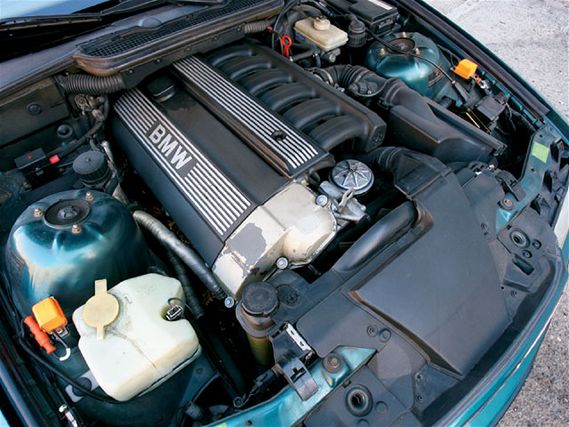 | It's not the cleanest car around, but it's cheap, rear-wheel-drive, reliable and comfortable. Plus, it doesn't need a turbo to make torque.
| It's not the cleanest car around, but it's cheap, rear-wheel-drive, reliable and comfortable. Plus, it doesn't need a turbo to make torque.
The BMW 3 Series has played more than a small role in defining the term 'sport compact car' and has been around for five generations, sweeping up a massive following with each one. So it's taken us long enough to acquire a 3 Series. But if nothing else, our procrastination has allowed us to pick up this 1993 BMW 325i at a time when anyone selling more than lemonade can now consider cars with blue-and-white propellers on their hoods.
And we're glad we did. There's something so right about the 3 Series: a venerable inline-six stashed lengthwise in the nose, transmission filling the hump between driver and passenger, and driven wheels in the back-just the way it should be (rear-wheel drive snob! -AH). The steering is direct and talkative enough to make you wonder why anyone would blow $50,000 on a new model.
Maybe some BMW fans were hoping for an E30 and something characteristically crazy, like an SR20DET engine swap, but it ain't gonna happen. And the reason is simple. You can steal an E36-chassis BMW (1991 to '99 3 Series) on craigslist.org as easily as you can an E30 (82 to '91 3 Series) and they're just as good, if not better. On top of the E30, the E36 has more horsepower and more structural rigidity too. Wanna talk engines? The iron block 2.5-liter (dubbed the M50) has a 10.5:1 compression ratio, and loves to be turbocharged. In stock form, the '93 325i produces 189bhp (more than an E46 325i) and will reach 60mph in less than seven seconds.
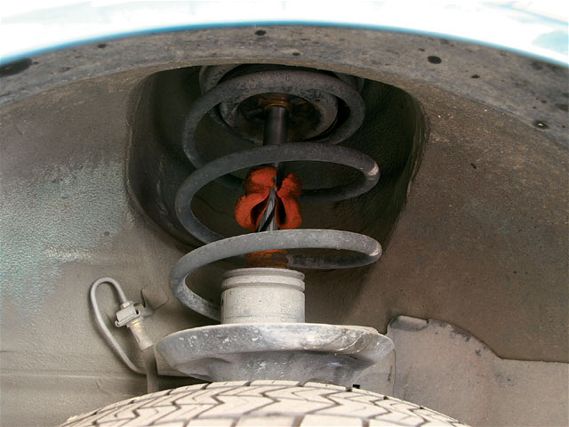 | With the original stock suspension near death, there was plenty of room for improvement. There also wasn't much point in hitting any track days with a setup 172,000 miles old.
| With the original stock suspension near death, there was plenty of room for improvement. There also wasn't much point in hitting any track days with a setup 172,000 miles old.
So that's out of the way. But why is this one a four-door? And for God's sake, why is it green? Well, speaking of structural rigidity, the sedan has a thicker B-pillar and the doors have frames. It doesn't weigh much more than the coupe, either. Besides, if anyone hasn't noticed, the cool factor of sedans has been going up steadily with the years, while that of coupes, sadly, has been declining. Oh, and it's green because it was $2800.
That $2800 bought a one-owner, no-accident, southern California car. It's loaded with ice-cold A/C and power seats for both driver and passenger. On top of that, there are none of the tell-tale electrical issues known to plague the E36-all the instrument lights work every time and there are no mechanical gremlins to speak of. Sure, it has 172,000 miles on the clock, but it's stronger than any of the six other 325s we tested before buying this one. A quick look underneath when it was on the lift revealed no leaks. Considering a used 325 engine can be had for around $500 (and every other E36 we found in this condition cost at least $1700 more) the choice was obvious.
Just a few things, though: the tires were utterly bald and the suspension was completely shot. But, for a true automotive enthusiast, that's a good thing. Blown factory components provide a perfect way to wipe a conscience clean and rationalize the purchase of aftermarket stuff.
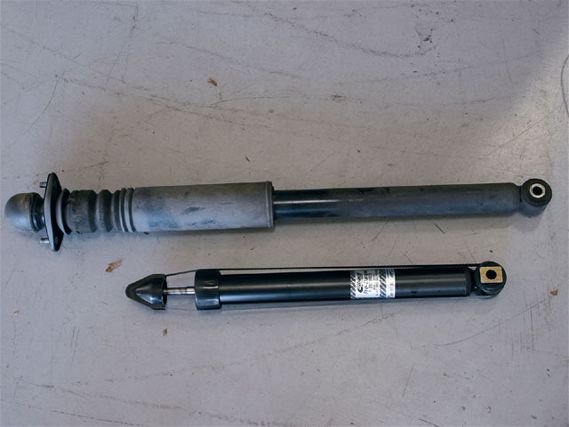 | Eibach also supplies a set of Pro-Dampers in the Sportline System Plus kit. These are valved to match the included springs. The Pro-Dampers aren't this short when compared to stock, they're compressed during packaging.
| Eibach also supplies a set of Pro-Dampers in the Sportline System Plus kit. These are valved to match the included springs. The Pro-Dampers aren't this short when compared to stock, they're compressed during packaging.
Which is what we do best, but we needed a goal before ordering a random amalgam of parts and hoping the car worked right. It didn't take long to arrive at our simple goal: we wanted to build a German alternative to the Japanese steals-on-wheels now flooding the market, like the Nissan 240SX and Mazda Miata. Those cars are big hits for one big reason: they're rear-wheel-drive and cheap. So we're out to prove that the rear-wheel-drive BMW has the same hit potential as the Miata and the 240SX.
We'll build a solid daily driver that we can feel safe bashing around the track on weekends. It's cheap, so we'll keep our modifications that way. As always, we'll complete the car in a series of installments, starting from basic suspension tweaks but spanning to the design and build of a high-compression engine. In doing so, we'll attempt to prove that the 325i isn't as risky, slow or expensive a purchase as is generally assumed.
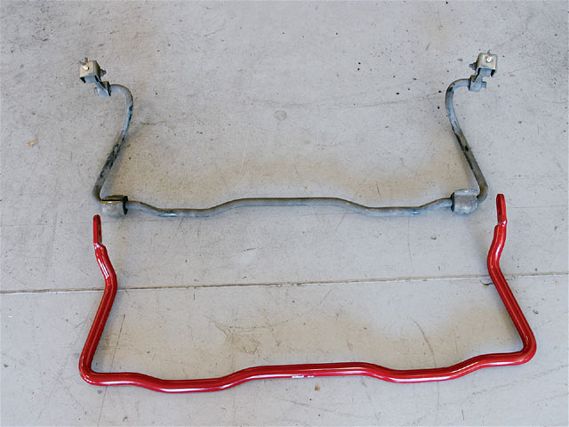 | Eibach's anti-roll bars are quite a bit thicker than stock (28mm front and 21mm rear, versus 24mm front and 15mm rear non-Sport Package), especially in the rear-which is a big plus for oversteer fans. Now we need to tweak Project BMW's alignment and become oversteer fans again.
| Eibach's anti-roll bars are quite a bit thicker than stock (28mm front and 21mm rear, versus 24mm front and 15mm rear non-Sport Package), especially in the rear-which is a big plus for oversteer fans. Now we need to tweak Project BMW's alignment and become oversteer fans again.
Our solution starts with new wheels, tires and suspension. A call to The Tire Rack lands us a set of BBS RK wheels (17x8 all around) and some sticky Dunlop Direzza Z1 rubber, in a very reasonable 235/40R17 size. Within minutes, our fit is confirmed, the order placed and the company put a set in the mail, already mounted and balanced. They even threw in an extra set of lugnuts. There's a reason we use these guys again and again.
And don't confuse the Direzza Z1s with Dunlop's drift-boy offering, the DZ101. The Z1s are brilliant-sticky to the limit with progressive breakaway. By the time you read this, Dunlop will have a new version of the Direzza Z1, the Direzza Z1 Star Spec, offering even greater initial cold grip, which is helpful during autocross events.
The 17x8 wheels are of a one-piece cast design and weigh a respectable 18.4 pounds each. We're so set on using BBS RK wheels (+35mm offset) that we're willing to put up with a some rub in the rear. Also, it turns out the rubbing rarely happens-when it does, it's only on the driver's side. Eventually, a little Dremel action on the rear bumper outhang will solve the problem.
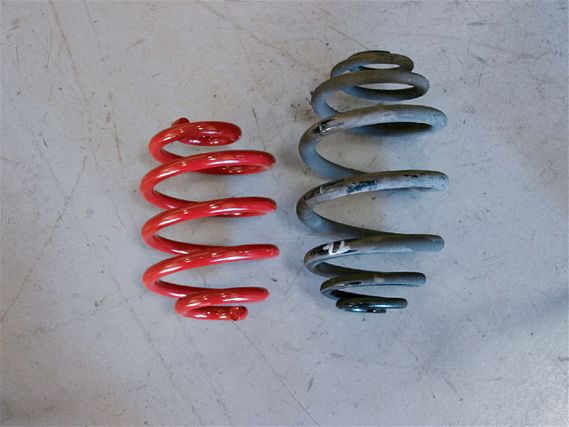 | Compared to the stock items, Eibach Sportline springs are noticeably shorter, although we would have preferred a stiffer rate and higher ride height, as offered by Eibach Pro springs.
| Compared to the stock items, Eibach Sportline springs are noticeably shorter, although we would have preferred a stiffer rate and higher ride height, as offered by Eibach Pro springs.
Put big and sticky rubber on a stock luxury sedan with shot suspension and you're in for a wild ride. Rather than find out how accurately we could mimic the Titanic during its final moments, we're taking the car straight to Eibach Springs in Corona, California. The company's Sportline System Plus kit should be the perfect compromise between looks, handling and everyday driveability. The kit includes Eibach's Sportline springs, Sachs dampers and a set of adjustable anti-roll bars (28mm front, 21mm rear).
The Eibach kit includes most of the hardware necessary for a plug-and-play solution, but some stock parts must be swapped, like spring perches and bumpstops. In a vehicle this old, there's a 90-percent chance the bumpstops are shot (see photo), so it's a good idea to have new stops handy before beginning the install.
The need to re-use stock hardware means that the spring must be separated from the stock front strut. In this case, the compression force of 10,000 elephants is required. In our many years of compressing springs for suspension installs, we've never needed pressure quite like this. Despite a crowbar and the help of Eibach's humongous floor-mounted spring press, the process is arduous. And slot in some extra time to dismantle the trunk. It's a BMW, not a Honda.
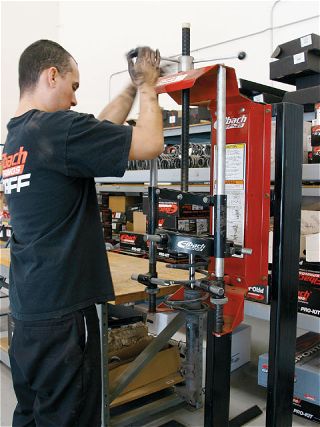 | In order to re-use the stock top mounts, we had to compress the stock springs and disassemble the parts. Those unlucky types without access to a spring compressor this mighty should invite over a bunch of burly, helpful friends.
| In order to re-use the stock top mounts, we had to compress the stock springs and disassemble the parts. Those unlucky types without access to a spring compressor this mighty should invite over a bunch of burly, helpful friends.
When our newly revitalized 325i finally comes off the rack, the effect of the significantly shortened springs is evident. Evident enough to make us question whether this could possibly be optimal suspension geometry. Nevertheless, the car feels better than it did (not a difficult feat). The anti-roll bars do a great job of eliminating body roll, while allowing (read: compensating) for a relatively soft spring rate. In hindsight, if we had to do it again, we would definitely opt for Eibach's Pro System Plus kit that swaps the Sportline springs for Pro springs, utilizing a higher spring rate and ride height.
As a result of the lowering, the back end has picked up a lot of negative camber. That's all fine and good when there's matching lean up front, but this isn't deliberate. The rear suspension has three times the camber of the front. Big rear anti-roll bar or not, the car understeers relentlessly when pushed. For a rear-wheel-drive car with 50/50 weight distribution, there's no excuse.
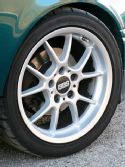
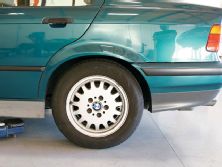
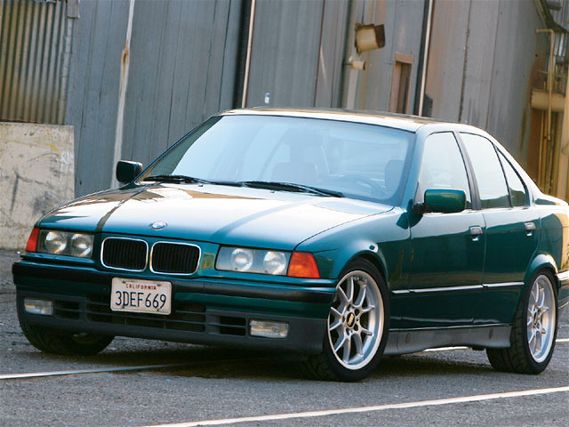 | For upcoming installments, we're thinking a baseline, then mild engine work, brakes on a budget and seeing how much weight we can tear out. Should be fun.
Cost Breakdown MSRP Eibach Sportline System Plus $1498.00 ($1195.00 street price) BBS RK, 17x8 (+35mm) $310.00 (each at The Tire Rack) Dunlop Direzza Z1, 235/40/17 $198.45 (each)
| For upcoming installments, we're thinking a baseline, then mild engine work, brakes on a budget and seeing how much weight we can tear out. Should be fun.
Cost Breakdown MSRP Eibach Sportline System Plus $1498.00 ($1195.00 street price) BBS RK, 17x8 (+35mm) $310.00 (each at The Tire Rack) Dunlop Direzza Z1, 235/40/17 $198.45 (each)
